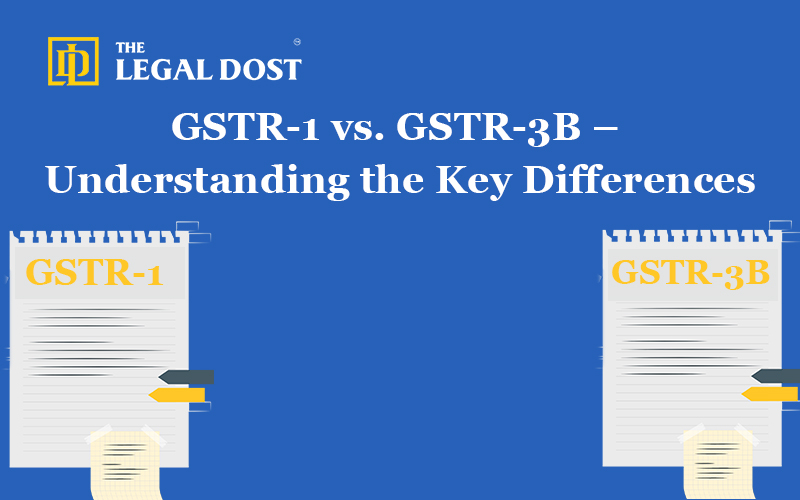For businesses operating under the GST compliance India framework, understanding the various GST return forms is crucial to avoiding penalties and ensuring smooth tax operations. Among the most significant returns are GSTR-1 vs GSTR-3B, both of which play pivotal roles in tax filing. However, the difference between GSTR-1 and GSTR-3B lies in their purpose, filing process, and reconciliation requirements.
What is GSTR-1?
GSTR-1 is a comprehensive return that captures details of outward supplies (sales) for a specific tax period. It includes invoices, debit/credit notes, and any modifications to previous transactions. Businesses must file this return either monthly or quarterly, depending on their turnover. The GSTR-1 due date varies based on the taxpayer category:
- Monthly Filers: Businesses with a turnover exceeding Rs. 1.5 crore must file by the 11th of the following month.
- Quarterly Filers: Businesses with a turnover of up to Rs. 1.5 crore must file by the 13th of the month following the quarter-end.
What is GSTR-3B?
GSTR-3B is a simplified summary return used to declare total sales, purchases, input tax credit (ITC), and tax liabilities for a given month. Unlike GSTR-1, which contains invoice-level details, GSTR-3B filing process requires businesses to self-assess and pay their tax dues before submission. The return is filed monthly, and the due date is the 20th of the following month.
Key Differences Between GSTR-1 and GSTR-3B
Below are some differences between GSTR-1 and GSTR-3B:-
Aspect | GSTR-1 | GSTR-3B |
Content | Detailed report of outward supplies, including invoices and modifications. | Summary of sales, purchases, ITC, and tax liabilities. |
Purpose | Captures sales transactions to ensure consistency with buyers’ records. | Facilitates tax payments and self-assessment. |
Filing frequency | Monthly or quarterly, depending on turnover. | Filed monthly by all taxpayers. |
Reconciliation | Required to match with the recipient’s GST monthly return (GSTR-2A). | Used for tax liability summary, which must align with GSTR-1 reconciliation. |
Tax Payment | No tax payment required. | Tax payment is mandatory before submission. |
Penalties for Late filings | INR 200 per day (INR 100 each for CGST & SGST). | GSTR-3B late fees: INR 20 per day for nil returns, INR 50 per day for non-nil returns. |
Importance of GSTR-1 Reconciliation
Reconciliation between GSTR-1 and GSTR-3B is critical to avoid discrepancies, incorrect tax payments, and penalties. Mismatches can lead to notices from tax authorities and even GSTIN suspension. Regular reconciliation ensures:
- Accurate tax payments: Ensuring the tax paid in GSTR-3B matches the reported liabilities in GSTR-1.
- Error rectification: Identifying missing invoices or duplicate entries.
- Avoidance of penalties: Reducing the risk of interest liabilities and tax audits.
How to Reconcile GSTR-1 and GSTR-3B?
To maintain GST compliance India, businesses should reconcile both returns before filing GSTR-3B by:
Comparing invoices: Ensure all sales reported in GSTR-1 are also reflected in GSTR-3B.
Verifying tax payments: Check if the tax liabilities declared in GSTR-3B align with those reported in GSTR-1.
Correcting discrepancies: Any inconsistencies must be resolved immediately, and shortfalls should be paid along with applicable interest.
GST Return Amendment Process
If errors are detected after filing, businesses can make corrections through GST return amendment in the next tax period. However, amendments must comply with government regulations, and any discrepancies should be rectified promptly to avoid penalties.
Conclusion
A clear understanding of GSTR-1 vs GSTR-3B is essential for effective tax management. By adhering to filing deadlines, ensuring reconciliation, and proactively handling amendments, businesses can maintain GST compliance India and avoid unnecessary legal complications. Regular monitoring of GST return forms and reconciliation efforts will help businesses streamline their tax filing process efficiently.
GSTR-1 vs. GSTR-3B – Understanding the Key Differences (FAQ)
GSTR-1 is a return that captures detailed information about outward supplies (sales) for a specific tax period, including invoices, debit/credit notes, and modifications.
GSTR-3B is a simplified return summarizing total sales, purchases, ITC, and tax liabilities, which must be filed monthly with tax payments before submission.
Monthly filers must submit GSTR-1 by the 11th of the following month, and quarterly filers must submit it by the 13th of the month after the quarter ends.
Monthly filers must submit GSTR-1 by the 11th of the following month, and quarterly filers must submit it by the 13th of the month after the quarter ends.
Discrepancies between GSTR-1 and GSTR-3B can lead to penalties, notices from tax authorities, and even GSTIN suspension.
It ensures accurate tax payments, corrects errors, and avoids penalties by matching tax liabilities and resolving discrepancies.
Reconcile by comparing sales reported in both returns, verifying tax payments, and correcting any discrepancies before filing GSTR-3B.
Errors can be corrected in the next tax period by filing an amended return, following government guidelines.


